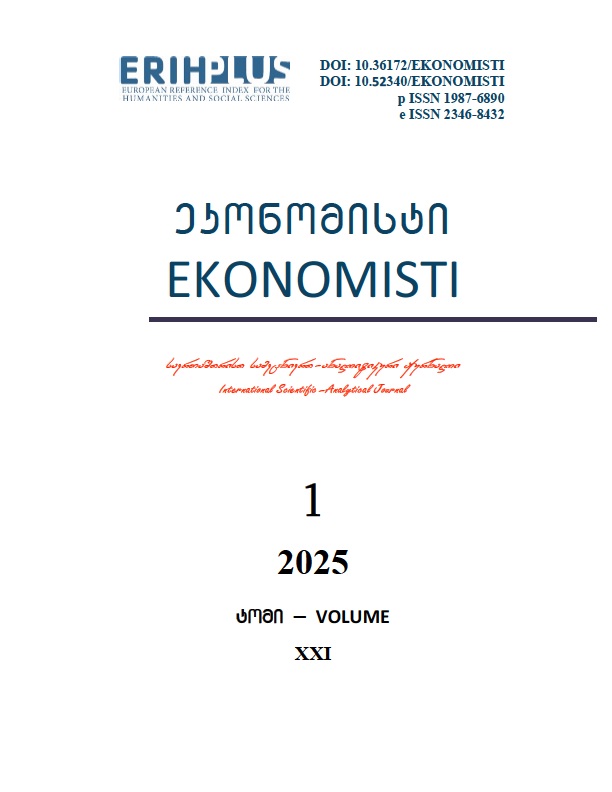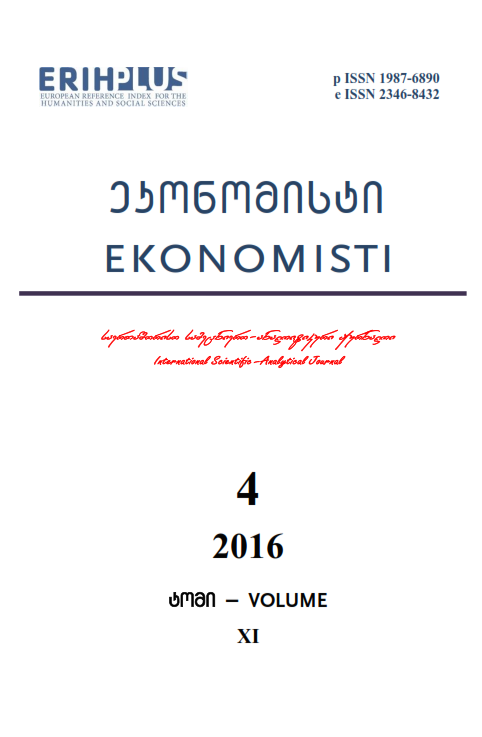
The international scientific and analytical, reviewed, printing and electronic journal of Paata Gugushvili Institute of Economics of Ivane Javakhishvili Tbilisi State University
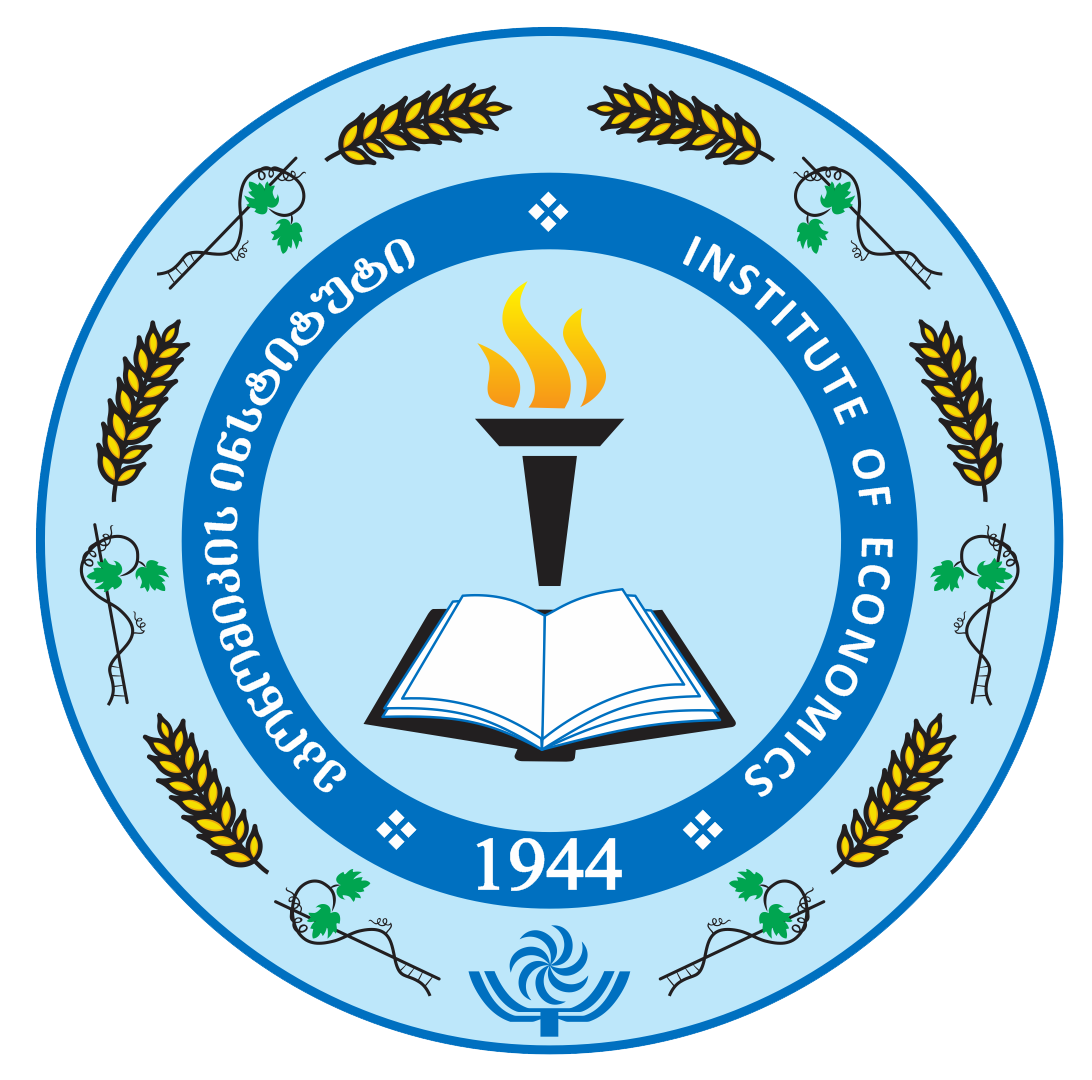
The Role of Internal Audit for Corruption and Fraud Prevention in the Georgian Public Administration
,,Integrity, Transparency and the fight against Corruption have to be part of the culture.
They have to be thought as fundamental values
Angel Gurria[1]
Resume. Effective Management of State Budget is the subject of interest of legal and physical person-each citizen of the state. Corruption and fraud existing in the country always endanger the targeted management of budget funds.
It is confirmed by studies that millions of money are lost annually through fraud and corruption worldwide (1). In addition, Modern world practice shows that high risks of corruption are typical for the countries in the transition-stage, with weak economics and administrations. Unfortunately, Georgia is still among this countries. In terms of program budgeting, corruption and fraud impede the country's sustainable and stable development.
Despite the implemented activities in the public administration of Georgia, there is still a lack of good governance principles, effective financial management and comprehensive control mechanisms. In this regard, by studying and analyzing the modern world experience and taking into account the high degree of accountability of the government of the country, the article substantiates the role of internal audit in the prevention of corruption and fraud and proposes mechanisms for their elimination.
Key Words: Fraud, Corruption, Internal Audit, Risk, Control, Integrity, PIFC reform, COSO model
Introduction
Over the past two decades, Georgia has made significant strides in the fight against corruption and fraud. The country is the leader in the region according to the “Transparency International” 2018 research of Corruption Perception Index/CPI[2]. At the same time, in the post-Soviet space Georgia occupies a leading position with a low level of corruption. According to CPI, Georgia received 58[3] points out of 100-point scale, among the 180 countries (diagram N1[4]).
,,Corruption Perception Index/ CPI Georgia and Post-Soviet Union Countries -2018 year.“ Diagram N1

According to the same study, with regard to the Baltic states, where Western standards have begun to develop mechanisms to combat corruption and fraud much earlier, Georgia falls only behind Estonia in terms of corruption perceptions index. (Diagram N2).
Corruption Perception Index /CPI comparison of Georgia and Baltic Sea Countries - 2018 year. Diagram 2.

However, in the case of highly developed countries, relatively high levels of corruption still have a place (Figure 3).
Corruption Perception Index/CPI in relation with Developed Countries 2018 year.Diagram N3
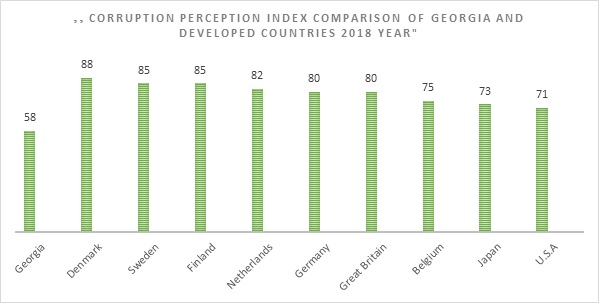
Georgia remains a high-risk country, as evidenced in the findings of different international organizations (OECD-ACN[5],GRECO[6], IDFI[7]), the State Audit Office, and Transparency International Georgia.
Georgia's success in fighting corruption was outlined in the OECD-ACN 2016 Monitoring Report : “Georgia is now at the next stage of the fight against corruption and, like many other countries, may face high levels of corruption and complex corruption. Georgia is in a strong position to address this challenge, but in order to succeed, it must not be complacent, it must be creative and active in the fight against corruption" (2). Transparency International Georgia[8] and State Audit Office reports also confirm the same.
In line with international practice, an important tool for the prevention of fraud and corruption in Georgian public organizations is well-organized Internal Control system, which is based on the EU model and includes the following elements:

The conceptual approach presented here is based on the concept of “Public Internal Financial Control/PIFC” developed by the EU for developing countries. Georgia, in the context of this ongoing reform, has taken obligation to establish Internal Audit Units in the Public Sector Organizations from 2010.
For the purposes of the current Public Internal Financial Control/PIFC reform, the organization's internal financial management and control system is based on the international COSO[9] model and operates through 5 (five) interrelated components, which can be schematically represented as follows:

According to the COSO model, internal audit is an integral part of the internal control system, although it does not participate in the establishment of the financial management and control system. It assesses the effectiveness of the system in practice and, on the basis of evaluation, makes appropriate recommendations for correcting and improving the existing conditions. Internal Audit improves governance, risk management and control processes through performance, information technology (IT), systems based, compliance and financial audits.
As within any reform, combating corruption and fraud will only have a positive outcome when the relevant audit reports prepared by the Internal Audit Unit, under the strong political will of the state, motivated executives, and effective monitoring services, specific action plans, become the subject of functionally established state institutions to detect, investigate, prevent and/or avoid corruption offenses. In order to address this problem, it is necessary to harmonize the existing legal framework of Georgia with international standards on internal audit. However, when transferring crime-related materials to the appropriate law enforcement agencies, which, under the Law of Georgia on Public Internal Financial Control, is only possible with the consent of the head of the institution, cannot guarantee a high degree of independence and impartiality of internal auditors. However, the Internal Audit Committee plays an important role in resolving the issue.
It should be noted that the scope of corruption and fraud risk assessments varies, depending on the size and complexity of the institution. Internal audit emphasize only the most important risks and vulnerable areas.
For the prevention of corruption and fraud risks, the timely and adequate response of the relevant state authorities to the violations identified in auditees is important. Georgia still lacks effective mechanisms in this regard. The study revealed that dozens of reports of possible crimes detected by the State Audit Office and Internal Audit Units have been sent to the relevant law enforcement agencies[10](diagram N4). Unfortunately, however, due to the lack of a unified feedback and monitoring system, internal audit units do not have information on further response.
Audit reports sent to law enforcement agencies 2017-2019 years. Diagram N4

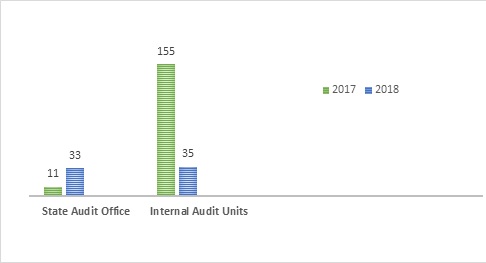
The role and responsibility of internal audit is important in preventing corruption and fraud risks (5), that is expressed by the evidence, internal audit provides to the management, as independent assurance on the adequacy and effectiveness of the internal control and fraud risk management system[11]. As for 2018, 108[12] internal audit units have been established in the Georgian Public Administration (Diagram N5).
Internal Audit Units in the Institutions Diagram N5

Auditors' competences are important to detect corruption and fraud. International Professional Practices Framework (IPPF) establishes a general professional order, criteria, qualification that is mandatory for any auditor in any workplace in the world.
Georgia still faces challenges in this regard, In terms of quantity, the number of internal auditors has tripled in comparison with 2012. By 2018, the number of internal auditors of public sector has reached 450. (Diagram N6)
Number of internal auditors employed in the public sector- Diagram N6

Proficiency of internal auditors in public administration organizations must comply with the requirements of international standards. According to the standard 1210 A2 (22), –“ Internal auditors must have sufficient knowledge to evaluate the risk of fraud and the manner in which it is managed by the organization, but are not expected to have the expertise of a person whose primary responsibility is detecting and investigating fraud“. However, Standard 2120 A2 states that- ”The internal audit activity must evaluate the potential for the occurrence of fraud and how the organization manages fraud risk”.In every audit engagement Professional skepticism, critical attitude and evaluation of audit evidence, is crucial. When internal auditors act with skepticism and concentrate on the effectiveness of internal controls, signs and incidents of fraud become more frequent. Even the best and most comprehensive internal control system, only reduces, but does not completely eliminate, the likelihood of fraud or irregularities. Internal audit should typically assess the likelihood of fraud and develop appropriate recommendations for the organization to manage fraud risks effectively.
Therefore, in line with the Public Internal Financial Control/PIFC model, an effective system of internal audit in public administration organizations, should provide management with appropriate recommendations, by identifying risks associated with fraud and corruption.
Practice shows that fraud and corruption signs reveal in various fields of public organizations activities and operations, including, it may be related to the , disposal of the misuse of material supplies, remuneration that does not belong to you, the right to use the assets, the bad faith of the auction and government procurement, issuing construction permits, incorrectly issued hospital sheet, transaction between related parties; misplaced fuel consumption, etc.
Public administration organizations identify various factors that cause fraud and corruption. For example, American sociologist Donald Cressey, who was employed in the field of criminology, created the so-called “The Fraud Triangle" and outlined three main factors: Pressure, Opportunity, Rationalize (diagram N7).
,,Fraud Triangle“ Diagram 7

In the fraud triangle the pressure may be due to the financial need, the large number of loans taken for objective or subjective reasons, the compulsion to achieve unrealistic working results; Opportunity - access to assets, to information, the ability to commit and hide fraud, deliberate actions; With rationalization, the crime can be justified, with the approach - "I work the most and I belong ...", "I asked it temporary, I will return later ...", " Everyone does this ..." Therefore, an in-depth study, analysis and evaluation of fraud, corruption, motives, factors, areas, and operations is the basis for the Internal Audit Department to develop appropriate recommendations for management.
Conclusion
At the current stage, internal audit is one of the most effective mechanism for combating fraud and corruption in public administration organizations. It’s Implementation and well-functioning, in terms of program budgeting, will facilitate the efficient management of budgetary funds.
In order to ensure stable and sustainable development of the country, and due to the need to eliminate corruption and fraud at the internal level of the organization, the advantage of the international COSO model of internal control is assessed and substantiated. Internal control under the COSO model - a set of processes managed by the institution's management and other personnel to achieve its’ goals and objectives ensure effectiveness and operability of activities within the organization, reliability of the information reflected in the financial reporting, compliance with applicable laws and legal acts. However, a shared understanding of the elements: control environment, risk assessment, control activities, information and communication, monitoring activities -is needed to achieve the stated mission and strategy.
Based on the COSO model of internal control, the paper proposes mechanisms for predicting inherent risks; Identifies opportunities and areas of influence; The need to develop a risk register; Aiming to raise awareness of the purpose of consultation; The ultimate responsibility of the management of the organization for managing the risks related to corruption and fraud; Creating a conscientious control environment, permanent retraining of staff, in terms of high degree of auditors independence; However, in order to effective operation of the internal audit system the need for systematic feedback on internal audit reports from law enforcement agencies is emphasized.
We think that the involvement of Georgia in the international projects, the systematic approaches and complex activities, including the Internal Audit well-functioning service, promote corruption and fraud risk prediction in the public administration organizations, and encourage further improvement of it’s elimination or minimization effective mechanisms.
To conclude all mentioned above, we outline the part from the speech of UN Secretary-General, António Guterres:“I urge people everywhere to continue to work on innovative solutions to win the battle against corruption and to ensure that precious resources serve the peoples of the world[13]”.
References
- Fraud and Internal Audit (IIA position paper) (2019) https://na.theiia.org/about-ia/PublicDocuments/Fraud-and-Internal-Audit.pdf;
- Internal Audit tool for minimizing the risk of fraud, Elzbieta Kllamut Financial internet quarterly ,,eFinanse” 30.03.2018, 49-68;
- GlenLehman,KymThorne.,Corruption,criminalityandtheprivatisedstate:Theimplicationsforaccounting; AccountingForum39(2015)366–370; www.elsevier.com/locate/procedia
- Daniela Petraşcu, Alexandra Tieanu., The Role of Internal Audit in Fraud Prevention and Detection; 21st International Economic Conference 2014, IECS 2014, 16-17 May 2014, Sibiu, Romania; Procedia Economics and Finance 16 ( 2014 ) 489 –497; www.elsevier.com/locate/procedia
- Association Agreement between Georgia and the European Union and the European Atomic Energy Union and their Member States on the one hand, 2014.r;
- UN Convention against Corruption, 2004.;
- Implementation Guide to the UN Convention against Corruption, 2006 .;
- Technical Guide to the UN Convention against Corruption, 2009.;
- Action Plan for the implementation of the National Anti-Corruption Strategy of Georgia and the National Anti-Corruption Strategy of Georgia 2017-2018;
- Georgian Law on “Public Internal Financial Control”
- Strategy for Public Finance Management Reform, 2018-2021 years;
- Public Sector strategic vision on Public Internal Financial Control (PIFC) reform , Government of Georgia,2009year.;
- Decree of the Government of Georgia “On Approval of Internal Audit Standards” N1847, Tbilisi, 2011., Amending the Decree N1015 of the Government of Georgia, 2010;
- Decree of the Government of Georgia “On Approval of the Code of Ethics of Internal Auditors” №1836, Tbilisi, 2011.;
- Resolution of the Government of Georgia on “Approving Internal Audit Methodology” N593, Tbilisi, 2016.;
- “Public Internal Financial Control System Development Strategy and Action Plan 2017-2019.;
- Department of Public Internal Control of the Ministry of Finance of Georgia / Harmonization Center Consolidated Annual Reports 2017-2018.;
- State Audit Office Activity Report 2017-2018.; Retrospective Assessment of the Public Internal Financial Control Law, 2018.;
- Resolution of the Government of Georgia on Approval of the Composition and Charter of the Inter-Agency Coordination Council against Corruption №390, 30/12/2013.;International Standards for the Professional Practice of Internal Auditing (Standards), Institute of Internal Audits;
- IPPF – Practice Guide, Internal Auditing And Fraud;
- Responding to Fraud Risk, IIA;
- INTERNAL AUDITING-Assurance & Advisory Services, IIA;
- IIA Standard 2060 : Reporting to Senior Management and the Board;
- INTERNAL AUDITING-Assurance & Advisory Services, IIA;
- Responding to Fraud Risk ( Farah G. Araj);
- Donald R. Cressey, Other People's Money (Montclair: Patterson Smith, 1973).
International Organizations Reports
- “Transparency International” Corruption Perception Index /CPI 2018 Reasearch;
- Public sentiment in Georgia: results of the March 2016 research; National Democratic Institute - NDI;
- IDFI-,,The Georgian National Anti-Corruption System is Ineffective against High Level Corruption”12.10.2018წ.;
- OECD-ACN First Round Monitoring Report - Georgia, 2006.;
- OECD-ACN- Second Round Monitoring Report - Georgia,2010.;
- OECD-ACN Fourth Round Monitoring Report - Georgia, 2016.;
- GRECO-First Round of Assessment – Georgia, 2000.;
- GRECO- Fourth Round of Assessment – Georgia, 2016.;
- Specialised Anti-Corruption Institutions, review of models, Anti-Corruption Network for Eastern Europe and Central Asia, OECD, 2008;
- Fighting Corruption in Eastern Europe and Central Asia, Asset Declarations for Public Officials A Tool to Prevent Corruption, 2011.
[1] Angel Gurria – Secretary General OECD/ Organisation for Economic Co-operation and Development
[2] CPI- Corruption Perceptions Index-The Global Corruption Index, that is published annually since 1995 by Transparency International. Countries are valued for their perceptions of corruption in the public sector. The document is based on the opinions of experts, public opinion polls and surveys of authoritative international organizations on the status quo of corruption in various countries.
[3] 100 points in the ranking indicate the lowest and 0 points the highest level of corruption perception.
[4] The diagrams presented by us (N1, N2, N3) are based on Transparency International's 2018 Survey of Corruption Perceptions Index / CPI; https://www.transparency.org/cpi2018
[5] OECD-CAN- Anti-Corruption Network of the Organization for Economic Cooperation and Development
[6] GRECO- Council of Europe’s Group of States against Corruption
[7] IDFI-Institute for Development of Information
[8] Georgia's Stalled Anti-Corruption Reforms: Unfulfilled Recommendations under the Istanbul Action Plan, August 09, 2019, www.transparency.ge
[9] COSO - The Committee of Sponsoring Organizations of the Tredway Commission , COSO IC – Internal Control Integrated Framework - private organization in the United States based on the good-will of membership that aims to provide relevant recommendations and guidelines for corporate governance (business ethics, financial reporting, internal control, risk management, etc.)
[10] The chart presented is based on the 2017-2018 annual reports of the State Audit Office and the consolidated annual reports of the Department of Public Internal Control (Harmonization Unit) of the Ministry of Finance of Georgia for 2017-2018.
Source https://sao.ge/files/auditi/2017-angarishi, pdf https://sao.ge/files/auditi/2018, www.pifc.gov.ge
[11] INTERNAL AUDITING-Assurance & Advisory Services, IIA pg. 8-16
[12]Internal Audit Unit is also established in following institutions: State Audit Office, Public Broadcaster, Central Election Commission, 4 Higher Education Institutions. However, according to the Law of Georgia on “Public Internal Financial Control”, the power of the Central Harmonization Unit do not extend to them.
